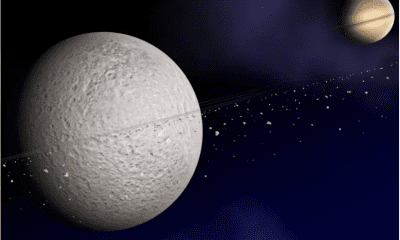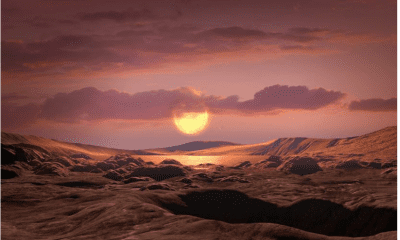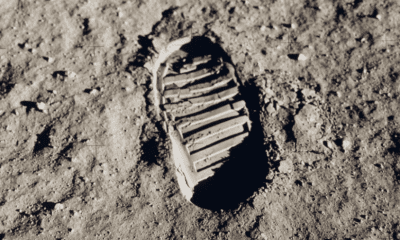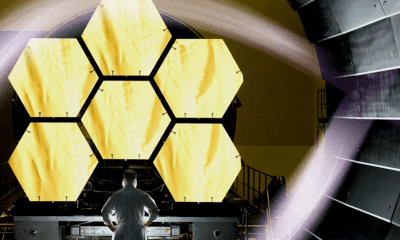Space
The biggest astronomical discoveries in the last 25 years
Published
2 months agoon


listNoun: ton.
Noun: tonne.
Noun: A strip of fabric, especially from the edge of a piece of cloth.
Noun: material used for cloth selvage.
Noun: The barriers or palisades used to fence off a space for jousting or tilting tournaments.
Noun: The scene of a military contest; the ground or field of combat; an enclosed space that serves as a battlefield; the site of a pitched battle.
Noun: A codified representation of a used to store data or in processing; especially, in the Lisp programming language, a data structure consisting of a sequence of zero or more items.
Noun: A little square moulding; a fillet or listel.
Noun: A narrow strip of wood, especially sapwood, cut from the edge of a board or plank.
Noun: A piece of woollen cloth with which the yarns are grasp by a worker.
Noun: The first thin coating of tin; a wire-like rim of tin left on an edge of the plate after it is coat.
Noun: A stripe.
Noun: A boundary or limit; a border.
Verb: To create or recite a .
Verb: To place in listing.
Verb: To sew together, as strip of cloth, so as to make a show of colours, or to form a border.
Verb: To cover with list, or with strips of cloth; to put list on; to stripe as if with list.
Verb: To plough and plant with a lister.
Verb: To prepare (land) for a cotton crop by making alternating bed and alleys with a hoe.
Verb: To cut away a narrow strip, as of sapwood, from the edge of.
Verb: To enclose (a field, etc.) for combat.
Verb: To engage a soldier, etc.; to enlist.
Verb: To engage in public service by enrolling one’s name; to enlist.
Verb: To give a building of architectural or historical interest listed status; see also the adjective .
Verb: To trade on a particular stock exchange.
Verb: To listen.
Verb: To listen to.
Verb: To desire, like, or wish (to do something).
Verb: To be pleasing to.
Noun: desire, inclination.
Noun: A tilt to a building.
Astronomy as a discipline has always aimed to answer fundamental questions about our place in the universe, so perhaps it would be best to start the list of the greatest astronomical discoveries on April 15, 1999, when the first exoplanetary system was discovered. Astronomers have discovered hundreds of stray worlds in the past 25 years that challenge the definition of a planet.
The biggest astronomical discoveries in the last 25 years
Other important discoveries include the discovery of the “God particle”, fluctuations in the fabric of spacetime, the sun’s missing neutrinos, and the first real clue about the nature of dark energy. In the following, we mention the most amazing discoveries of the last quarter of a century.
1999: Discovery of an exoplanetary system
 An artist’s rendering of the Upsilon Andromeda planetary system. In this system, three Jupiter-like worlds orbit the yellow-white star Opsilon Andromeda E.
An artist’s rendering of the Upsilon Andromeda planetary system. In this system, three Jupiter-like worlds orbit the yellow-white star Opsilon Andromeda E.
In April 1999, astronomers discovered three Jupiter-sized planets orbiting the yellow-white star Opsilon Andromeda E. This system, which is located at a distance of 44 light-years from Earth, is the first exosolar system that was discovered.
The aforementioned discovery challenged the concept that our solar system is a single phenomenon in the universe and showed that the discovery of other planetary systems depends on time and technology. Astronomers also realized in 2010 that, unlike the planets of the solar system, the Jupiter-like planets in this extrasolar system are not on the same plane; Rather, they have a 30-degree slope to each other. This finding helped scientists to revise the theories of the formation and evolution of planets. As of April 2024, astronomers have discovered 900 stars that host two or more planets.
2001: The first wandering planet of the Milky Way was discovered
 A depiction of a Jupiter-like wandering planet.
A depiction of a Jupiter-like wandering planet.
At the beginning of the 21st century, astronomers discovered the first stray planet near the Trapezium cluster, a stellar nursery near the heart of the Orion Nebula.
In our galaxy alone, there may be a quadrillion stray planets that have been ejected from the gas and dust disk of their birth. However, only a few of these planets have been discovered in the Milky Way; Because these planets are very dim and this feature makes them difficult to observe. These orphan planets are among the lightest products of stellar birth and carry important information about their formative environments.
2001: Discovery of the first exosolar asteroid belt around a Sun-like star
 Artist’s rendering of the night sky of a hypothetical alien planet in a star system with an asteroid belt 25 times heavier than the solar system’s asteroid belt.
Artist’s rendering of the night sky of a hypothetical alien planet in a star system with an asteroid belt 25 times heavier than the solar system’s asteroid belt.
In early 2001, NASA’s Spitzer Space Telescope discovered evidence of the first extrasolar asteroid belt around a Sun-like star called HD 69830, located 40 light-years away in the constellation Ursa Major. According to estimates, this belt is 25 times heavier than the main asteroid belt between the orbits of Mars and Jupiter. In 2005, astronomers discovered three Neptune-like planets orbiting this star, the outermost of which is probably located in its star’s life belt.
Astronomers are interested in the size and location of asteroid belts in multi-planetary systems; Because these stone fragments affect the merger of planets and even the emergence of life. According to a leading theory, asteroids brought water and biological material to the early Earth. This claim was strengthened by the discovery of water molecules in asteroid samples returned to Earth as well as space samples.
2001: The mystery of the Sun’s missing neutrinos was solved
 This view shows the Borexino stainless steel sphere. In this experiment, solar neutrinos were measured for the first time
This view shows the Borexino stainless steel sphere. In this experiment, solar neutrinos were measured for the first time
Physicists announced in June 2001 that they had discovered the Sun’s missing neutrinos. These neutrinos are actually subatomic particles without charge and practically without mass. The discovery ended a thirty-year search for tiny packets of energy but showed that these particles also have some mass.
Nuclear reactions at the heart of the Sun, the process by which the Sun shines, produce billions of neutrinos, half of which are estimated to travel 150 million kilometers to Earth. However, experiments in the late 1960s discovered a small number of these ghostly particles. Later, this mystery was raised as the solar neutrino problem.
Experiments by Canada’s Sudbury Neutrino Observatory in 2001 showed that the missing neutrinos actually transform into two types of neutrinos on their way to Earth, making them difficult to detect. This conversion requires that the neutrinos have a mass that is hundreds of thousands of times less than the mass of the second lightest particle, the electron.
2001: Discovery of the first exoplanet with an atmosphere
 This art rendering shows a dramatic view of the burning exoplanet HD 209458b in an orbit 7 million kilometers from its yellow Sun-like star.
This art rendering shows a dramatic view of the burning exoplanet HD 209458b in an orbit 7 million kilometers from its yellow Sun-like star.
Astronomers entered a new phase of exoplanet science in November 2001. Based on data from the Hubble Space Telescope, they discovered the existence of an atmosphere in an alien world. This exoplanet named HD 209458b is located at a distance of 150 light years in the constellation of the Big Horse. This planet is one of the first exoplanets known to host an atmosphere.
The aforementioned discovery marked a new era in the discovery of extrasolar planets, and since then astronomers can compare the atmospheres of extrasolar planets and the abundance of atmospheric gases for the formation of life on Earth.
2007: Fast radio bursts reveal the universe’s missing mass
 This visualization shows a fast radio burst escaping three colliding galaxies as it travels through the Milky Way.
This visualization shows a fast radio burst escaping three colliding galaxies as it travels through the Milky Way.
In 2007, astronomers using the Parkes Observatory in Australia discovered a Fast Radio Burst (FRB). A short, bright burst of radio waves originating in a galaxy billions of light-years from Earth. In just a few milliseconds, a bright burst called the Lorimer Burst FRB 010724 released as much energy as the Sun in 80 years. Since then, hundreds of such bright pulses have been discovered from distant galaxies, a few of which explode either continuously or irregularly.
Astronomers have used intense pulses of radio bursts to discover some of the universe’s missing material, hidden in intergalactic space. These materials were revealed by examining the distribution of radio waves from the motion of FRBs in the interstellar gas.
2012: Discovery of Higgs boson or God particle
 Artistic rendering of a Higgs boson
Artistic rendering of a Higgs boson
In July 2012, the field of particle physics attracted world attention with the discovery of the Higgs boson. The Higgs boson is a subatomic particle distributed throughout the universe as a field that gives mass to other fundamental particles. The existence of the Higgs boson was first independently proposed by physicists Peter Ver Higgs and Francois Englert in 1964. The God particle was discovered exactly half a century later during two experiments that took two years at the Large Hadron Collider in Switzerland. Higgs and Englert won the Nobel Prize in 2013 for their theory of how particles acquire mass.
2016: Discovery of gravitational waves and proof of Einstein’s theory
 An artist’s rendering of a set of pulsars affected by gravitational oscillations produced by a binary supermassive black hole in a distant galaxy.
An artist’s rendering of a set of pulsars affected by gravitational oscillations produced by a binary supermassive black hole in a distant galaxy.
In February 2016, scientists announced that they had detected gravitational waves last September using the Laser Interferometer Gravitational-Wave Observatory, or LIGO for short. Gravitational waves are weak oscillations in the fabric of space-time that Einstein predicted a century ago, and for the first time in 2015, one of the oscillations resulting from the collision of two black holes was discovered by ground detectors.
Because gravitational waves traveled intact through the very hot matter of the early universe, their discovery meant a new way of looking at the universe that was never possible with electromagnetic waves. The three physicists who helped discover gravitational waves are Rainer Weiss, Barry Brisch, and Kip Thorne. All three won the Nobel Prize in Physics in 2017.
In June 2023, another new era in gravitational wave astronomy dawned. At that time, scientists with the North American Nanohertz Gravitational Wave Observatory (NANOGrav) discovered evidence of a persistent hum of gravitational waves. They were highly suspicious of the hum, which had a frequency of one billionth of a hertz and was hundreds of times weaker than the gravitational waves discovered in 2015. The hum was a reflection of a pair of supermassive black holes orbiting each other.
2017: Discovery of the first interstellar visitor to the solar system
 Umwamwa, humanity’s first visitor to interstellar space
Umwamwa, humanity’s first visitor to interstellar space
In the fall of 2017, astronomers spotted a strange object in the solar system known as the first interstellar visitor. The object, known as Omuamoa, became the source of many mysteries, because its brightness was different from that expected for an asteroid, and on the other hand, it did not behave like a comet.
Some thought that Ummuamwa was an alien structure. Considered to be an asteroid, Umuamua was spotted as a comet in 2023, and a group of astronomers believed that the object was likely ejected from an exoplanetary system and accelerated by tiny amounts of hydrogen gas escaping from its icy core.
In 2019, astronomers discovered a second interstellar visitor named Borisov, whose cometary identity was soon revealed thanks to its gaseous tail. This stray object, which had never passed close to a star before the Sun, is one of the most pristine comets ever studied.
2019: First image of a supermassive black hole
 The Event Horizon Telescope, an array of eight radio telescopes on a global scale, captured this image of the supermassive black hole at the center of the galaxy Messier 87, or M87, and its shadow.
The Event Horizon Telescope, an array of eight radio telescopes on a global scale, captured this image of the supermassive black hole at the center of the galaxy Messier 87, or M87, and its shadow.
Astronomers photographed a black hole for the first time in 2019. The Event Horizon telescope captured an image of a supermassive black hole at the heart of the galaxy Messier 87, which is more than 50 million light-years away from Earth. This image provided a new way to study black holes, similar in importance to the first microscopic images of insects and plants.
Astronomers unveiled a new image of the black hole in 2021 that showed how magnetic fields behave near black holes. In 2023, the black hole was reconstructed by artificial intelligence and resembled an orange donut in a narrow ring. Astronomers have found that the black hole is rotating, although its speed is not known.
2020: The most detailed map of the Milky Way was prepared
 The 2020 map from the European Space Agency shows 1.8 billion stars, drawn from data from the Gaia spacecraft. This map shows the best view of the Milky Way and neighboring galaxies in color.
The 2020 map from the European Space Agency shows 1.8 billion stars, drawn from data from the Gaia spacecraft. This map shows the best view of the Milky Way and neighboring galaxies in color.
The most detailed map of the Milky Way in 3D maps nearly 1.8 billion stars with unprecedented precision, based on data from the European Space Agency’s Gaia spacecraft. Although this figure is very amazing, it includes only 1% of all the stars in the galaxy. According to astronomers, studying the movements of these drawn stars reveals ancient clues about the nature of dark matter.
2024: Starless and empty galaxies entered the field of view
 The dark galaxy J0613+52 with colors indicating the movement of gases against the direction of the Earth (red) and towards the Earth (blue)
The dark galaxy J0613+52 with colors indicating the movement of gases against the direction of the Earth (red) and towards the Earth (blue)
In January 2024, astronomers announced the discovery of a primordial galaxy that is so sparse that it still has no stars. This discovery challenged leading theories about how galaxies form and evolve, and even the definition of a galaxy. However, how can a galaxy be without stars?
At the same time, a different group announced the discovery of another nearly empty galaxy called Nube (the Spanish word for cloud), which is a single, isolated galaxy 300 million light-years away from Earth; The nearest large neighbor of this galaxy is at least 1.4 million light-years away.
Dark galaxies are hundreds of times dimmer than the Milky Way, which gets its light from 100 billion stars. Astronomers continue to puzzle over how such starless galaxies contain such pristine star-forming gas.
2024: Dark energy is evolving
 The largest 3D map of the universe shows that dark energy may be evolving over time.
The largest 3D map of the universe shows that dark energy may be evolving over time.
Physicists have long considered dark energy, or the mysterious force driving the universe’s expansion, to be a cosmic constant that remains unchanged throughout the universe’s history.
However, in April 2024, astronomers who created the largest 3D map of the universe showed that dark energy is evolving over time. This discovery could be the first clue about this mysterious phenomenon over the past two decades and, if confirmed by future data, would be as revolutionary as the discovery that the universe is expanding faster.
2024: Dwarf galaxies fill the early universe with light
 An image of the Pandora cluster from NASA’s James Webb Space Telescope
An image of the Pandora cluster from NASA’s James Webb Space Telescope
Astronomers have long wondered how the universe emerged from the cosmic dark ages when it was shrouded in a dense haze of neutral hydrogen gas. In early 2024, astronomers using the James Webb Space Telescope (JWST) showed that dwarf galaxies within a few hundred million light-years of the early universe formed the first primordial lights. This discovery proves the unprecedented infrared capabilities of the James Webb Telescope, which allows it to collect light from the faintest objects.
The amazing discoveries of the James Webb Telescope and the prospects it has provided since its launch in 2022 have stunned the world. For example, this telescope recorded the “pillars of creation” with unprecedented detail and revealed the colorful patterned curtain of the formation of dust clouds and cosmic processes in this region.
The James Webb Telescope continues to amaze astronomers and the public with detailed images of the universe’s most distant galaxies, supermassive black holes, and exoplanets.


You may like
-




Why do none of the moons of the solar system have rings?
-




Most alien planets probably do not have day or night
-




The biography of Edwin Hubble
-




Can telescopes see astronaut footprints on the moon?
-




Can you really see the Great Wall of China from space?
-




The James Webb Space Telescope; A look at the vastness of the universe


Why do none of the moons of the solar system have rings?
We have many strange moons in our solar system. hot and cold moons; Moons with liquids and dusty moons. One lunar planet is walnut-shaped and another is potato-shaped; But among almost 300 moons that have been discovered so far, not even one of them has rings. This is really strange.
Of the eight planets in the solar system, half have rings of dust and ice that orbit their equator. It is thought that Mars once had a ring, and according to new research, even our blue planet probably had a ring similar to Saturn’s ring about 500 million years ago, which lasted for tens of millions of years.
In addition, some dwarf planets also have rings; Although astronomers have not yet been able to understand how these rings are formed. Even some asteroids have their own rings.
While investigating the concept of ringed moons outside our solar system, Mario Socercchia, an astrophysicist at the Universidad Adolfo Ibánez in Chile, and his colleagues became involved in the question of why moons in our own cosmic neighborhood lack rings. In an interview with Science Alert, he explains:
If the giant planets of the solar system have rings, and if the asteroids beyond the orbit of Jupiter and the non-Neptunian bodies also have rings, why don’t the moons of the solar system have rings? This absence is illogical considering the presence of rings in other places. As a result, it is better to investigate whether there are underlying dynamical reasons that prevent the formation of rings or their long-term stability around moons.
 James Webb Space Telescope image of the rings of the planet Uranus.
James Webb Space Telescope image of the rings of the planet Uranus.
We have yet to definitively discover an extrasolar moon, but in 2021 Soserkia and his colleagues hypothesized that if a moon had a large ring system, it could engineer its existence by blocking enough starlight. But the group later realized that we have yet to see any ringed moons, so the likelihood of their existence is very low.
When you’re an astronomer with a question in mind and a simulation tool at hand, there’s only one thing you can do: build models of cosmic systems and see what happens when you set them in motion.
There are many raw materials from which rings can form around the moons of the solar system. Some of these materials are dust resulting from the formation of impact craters. Some other moons emit steam or gas of their own, so there seems to be no problem with ring formation.
Considering the gravitational influence of the moon, host planet and other moons, researchers designed and tested physical N simulations and realized that due to these variables, ring formation around moons is difficult.

For example, Saturn’s moon Enceladus releases water vapor, ice particles, and gases from its glaciers in the Antarctic region with its remarkable surface activity. However, instead of forming a ring around this moon, these materials are transported into Saturn’s orbit by strong interactions with neighboring moons, feeding Saturn’s E ring.
In other words, even though the moons produce part of the raw materials necessary for the ring, their surrounding environment makes a large part of these materials available to the host planet and prevents the formation of the ring around the moons themselves.
So far, NASA has discovered 293 moons in the orbit of the planets of the solar system, most of which belong to the planets Jupiter and Saturn. Also, moons around dwarf planets and even asteroids have been discovered.
Soserkia and his team simulated the moons of a variety of solar system objects, from the Earth’s moon to the larger moons of Jupiter and Saturn, over millions of years of evolution. They sought to investigate the stability of these objects, their gravitational environment, possible ring systems, and their changes over time. The results of the investigation were contrary to the expectations of the researchers. Susarkia explains about this:
At first I expected rings to be completely unstable, which directly answered our question. However, contrary to expectation, we found that these structures have maintained their stability in many conditions. Indeed, in a previous paper we showed that isolated moons can have stable rings, but we did not predict that moons would remain stable in harsh gravitational environments despite the large number of other moons and planets that have distributed their rings. Another surprise came when we realized that these harsh environments, instead of destroying the rings, beautified them by creating structures like cracks and waves, which were just like what we see in Saturn’s rings.
 Saturn’s moon Iapetus with its prominent equatorial ridge.
Saturn’s moon Iapetus with its prominent equatorial ridge.
Some features of the moons of the solar system are signs of the past of the rings. The simulations suggest that the pebbles found orbiting Saturn’s moon Rhea could be the last remnants of a complete ring system. Also, Saturn’s moon Iaptus has a equatorial groove, which could be the remnant of a ring that fell on this moon, and in this sense, it is just like Saturn’s rings that slowly fall on this gas giant.
The findings show that the reason we do not see rings in the solar system today is that we are not in the right time and place. Solar radiation pressure, magnetic fields, internal heating, and magnetospheric plasma all contribute to the loss of once-existing lunar rings. According to Susarkia:
I believe we are unlucky to some extent; Because we started observing the universe during a period when these structures no longer exist. After doing this research, I was convinced that these rings probably existed in the past.
On the other hand, the only reason we see Saturn’s rings is because we are in the right place and time. For this reason, we see solar and lunar eclipses; Because the moon is gradually moving away from the earth and at some point it will be so far that it can no longer completely cover the sun.
 The glory of Saturn’s rings.
The glory of Saturn’s rings.
The researchers believe that further simulations that take into account more parameters, such as beam pressure and magnetic fields, can help us understand the absence of lunar rings in more detail. We should also look more closely at the moons and look for evidence of the past, such as the craters on Iaptus.
At the same time, Suserkia and his colleagues are looking to expand their search and look for moons of rings around alien extrasolar worlds. He explains:
I wonder what mythical and epic stories we will hear from the inhabitants of other worlds about ringed moons. I mean, how will their stories and culture about the moons of the rings be different from our stories? There are infinite possibilities.
The scientists’ research has been accepted for publication in the Journal of Astronomy and Astrophysics and is available in the archive database.


Most alien planets probably do not have day or night
Do aliens sleep? You may take sleep for granted, but research suggests that many possible life-hosting planets may not have a day-night cycle. It is difficult to imagine the absence of day and night, but right now on Earth there are creatures living in lightless habitats in the depths or on the seabed, and they offer a vision of alien life without the existence of a circadian rhythm.
There are billions of potentially habitable planets in our galaxy; But how do we get to this number? The Milky Way has between 100 billion and 400 billion stars, seventy percent of which are cold and small red dwarf stars or M dwarfs.
According to a detailed survey of exoplanets in 2013, approximately 41% of red dwarf stars have a planet in their life belt. At this distance, the planet has the right temperature to support liquid water; Therefore, these planets have the potential to host liquid water.
We still do not know which of the discovered exoplanets have liquid water. However, 28.7 billion planets are only in the red dwarf life belt. We have not even considered the statistics of other types of stars like our sun.
 Planets close to red dwarfs are fatally locked to their star
Planets close to red dwarfs are fatally locked to their star
Rocky planets in the habitable belt of an M dwarf are called M Earths. M-Earths are fundamentally different from our Earth. One difference is that M dwarf stars are much cooler than our Sun. Also, M Earths are located at a close distance from their star, and for this reason, the gravitational influence of the star on them is strong.
The star’s gravity exerts a stronger force on the near side of the planet than on the far side. By creating friction, the planet’s rotation slows down until its orbital and translational rotations become synchronized over millions of years. Thus, M fields are likely to be deadlocked; So that one hemisphere of them is always facing the star and the other hemisphere is always behind it.
The year of a mortally locked planet is as long as its day. Earth’s moon also has a deadly lock on us. For this reason, we always see one side of it and cannot observe its hidden side.
A planet in mortal lock looks strange, But most possible habitable planets are of this type. Our nearest planetary neighbor, Proxima Centauri b, located in the Alpha Centauri system four light-years from Earth, is likely a fatally locked M-Earth.
As a result, unlike our Earth, M Earths have no day or night and even seasons; But terrestrial life, from bacteria to humans, has circadian rhythms corresponding to the day and night cycle. Sleep is one of the most obvious consequences of circadian rhythm.
On Earth, some creatures live in absolute darkness
The circadian cycle affects biochemistry, body temperature, cell regeneration, behavior, and much more. For example, people who are vaccinated in the morning produce more antibodies than people who are vaccinated in the afternoon; Because the response of the immune system is different during the day.
We cannot yet say with certainty how much periods of inactivity and regeneration affect life. Perhaps organisms that evolved without cyclical time never needed to rest.
If you doubt it, you can look at terrestrial organisms such as cave dwellers, deep sea life, and microscopic organisms in dark environments such as the earth’s crust and the human body that thrive in space away from daylight.
Many life forms have biological rhythms that are synchronized to stimuli other than light. Naked burrowing mice spend their entire lives underground and never see the sun, But their day and night hours are proportional to the daily and seasonal cycles of temperature and rainfall. Also, deep-sea bivalves and thermal well shrimps coordinate with ocean tides.
Bacteria that live in the human gut synchronize with melatonin fluctuations in the host’s body. Melatonin is a hormone in the body that is produced in response to darkness. Temperature changes that occur in thermal wells, humidity fluctuations chemical changes, and environmental currents can all cause biological fluctuations in the body of living organisms.
According to new research, M-Earths can have alternate cycles for days and seasons. To evaluate days and seasons on exoplanets, scientists have adapted climate models to simulate the environment of M-Earths and planets such as Proxima Centauri b.
According to the simulations, the contrast between the night and day sides of the planets produces gusts and atmospheric currents similar to Earth’s gust currents. If a planet has water, its dayside is likely to have thick thunderclouds.
The interaction between winds, atmospheric waves, and clouds can change the climate and produce regular cycles of temperature, humidity, and rainfall. The length of these cycles varies from hundreds to thousands of Earth days depending on the state of the planet, But it has nothing to do with the rotation period of the planet. Although the stars in the sky of these planets remain constant, the environment changes.
Perhaps life on M-Earths evolved to match biological rhythms and climatic cycles, or perhaps evolution arrived at a more exotic solution. One can imagine species that live on the day side of the planet going to the night side to rest and regenerate themselves.
These descriptions remind us that if life is out there, it can challenge assumptions we don’t know exist. The only certainty is that it will surprise us.


nameNoun: Any nounal word or phrase which indicates a particular person, place, class, or thing.
Noun: reputation.
Noun: An abusive or insulting epithet.
Noun: A person (or legal person).
Noun: Those of a certain name; a race; a family.
Noun: authority; behalf.
Noun: A unique identifier, generally a string of characters.
Noun: An investor in Lloyd’s of London bearing unlimited liability.
Verb: To give a name to.
Verb: To mention, specify.
Verb: To identify as relevant or important
Verb: To publicly implicate by name.
Verb: To disclose the name of.
Verb: To designate for a role.
Verb: To initiate a process to temporarily remove a member of parliament who is breaking the rules of conduct.
Noun: Any of several types of true yam () used in Caribbean Spanish cooking.
SProper noun: in which several of the axioms of ZF are derivable as theorems.
Noun: Any nounal word or phrase which indicates a particular person, place, class, or thing.
Noun: reputation.
Noun: An abusive or insulting epithet.
Noun: A person (or legal person).
Noun: Those of a certain name; a race; a family.
Noun: authority; behalf.
Noun: A unique identifier, generally a string of characters.
Noun: An investor in Lloyd’s of London bearing unlimited liability.
Verb: To give a name to.
Verb: To mention, specify.
Verb: To identify as relevant or important
Verb: To publicly implicate by name.
Verb: To disclose the name of.
Verb: To designate for a role.
Verb: To initiate a process to temporarily remove a member of parliament who is breaking the rules of conduct.
Noun: Any of several types of true yam () used in Caribbean Spanish cooking.
The biography of Edwin Hubble, the legendary astronomer who discovered the extragalactic space
Edwin Powell Hubble known as Edwin Hubble was a famous American astronomer who played an important role in formulating the basic principles of extragalactic and observational astronomy. Historians and astronomy experts consider him one of the most important astronomers in history. Hubble placed the space clouds, which before her time were known as gas and dust particles and were in the category of nebula or nebula, in the category of galaxies.. Historians consider Hubble’s discovery of other galaxies equal to Copernicus’ theory in terms of scientific value. Copernicus proved that the Earth is not at the center of the solar system, and Hubble proved that the Milky Way is not the center of the universe.
One of the important scientific relics of this astronomer is Hubble’s law in space. In short, this law states that the universe is expanding at a constant rate. In addition, in this law, the distance of each galaxy from the edge of the universe is directly proportional to its speed. Of course, this law was discovered two years before Hubble’s presentation by Georges Lemaitre, but its fame came to Hubble. The Hubble telescope is one of the most famous monuments built in the name of this legendary astronomer. An example of this telescope is installed in his hometown of Marshfield, Missouri. This telescope was sent into Earth orbit in 1990 to capture more detailed images of space outside the Milky Way.
Edwin Hubble has another great achievement in the field of cosmology and that is the classification of galaxies. This classification has been used by astronomers for many years. Hubble played a significant role in adding the astronomy category to the Nobel Prize. Of course, the sudden death of this scientist in 1953 prevented him from receiving this award.

Birth and education
Edwin Hubbell was born on November 20, 1889, in Marshfield, Missouri. His mother was Virginia Lee James and his father was John Powell Hubble. His father was a lawyer and insurance businessman. Edwin was the third child out of 8 children in this family. Of course, like many children of those years, some of Edwin’s siblings died in childhood.
Hubbell lived in a rich family that had to migrate many times because of his father’s work style. During these trips, which were generally in cities around Chicago and Illinois, they lived in luxurious houses with many servants. The children of the Hubble family were all brought up with work and responsibility; Because their parents believed that this style of upbringing would increase their sense of responsibility.
Edwin Hubble was very interested in sports as a child and teenager
As a child, Edwin struggled to keep up with his older siblings and students, so he learned to read before school. He was very fond of adventure books by Jules Verne and H. Rider Haggard. Edwin’s grandfather was an amateur but enthusiastic astronomer. At the age of 7, he got acquainted with one of his grandfather’s telescopes and had his first experience of space exploration. The interesting thing is that instead of participating in the celebration, he observed the space with this telescope on his 8th birthday.
Hubble completed his high school education at Wheaton High School near Chicago. He finished high school easily and with excellent grades in English, mathematics, biology, chemistry, physics, Latin, and German languages. Of course, in high school, Edwin was more into sports than studying, and he owed his high grades to his innate intelligence. On his father’s advice, he was busy delivering goods on holidays. Finally, Edwin Hubbell graduated from high school in 1906 at the age of 16 and received a scholarship to the University of Chicago. He worked at this university as a laboratory assistant of the famous physicist Robert Millikan (Nobel Prize winner).

Edwin Hubble (left), with friends after returning from Oxford
After entering the university, sports still occupied a large part of Hubble’s time. He was fond of sports such as basketball and boxing. He was a tall and strong person and he left several records during his university days. Edwin Hubble graduated from the university in 1910 with a bachelor’s degree in general science and honors in physics and astronomy.
After graduating from the University of Chicago, Hubbell entered Oxford University with a Rhodes scholarship and studied there for three years. Hubble was quickly influenced by English culture and changed many of his past behaviors and habits and adopted an English appearance. Contrary to his strong interest in experimental sciences and especially astronomy, he chose the field of law theory out of respect for his father and graduated from Oxford in 1912. He stayed at this university for another year and studied Spanish. While studying at Oxford, Hubble had another achievement including traveling around Europe. In these trips, in addition to having fun, he paid special attention to planning and thinking about his future. In those years, Edwin wrote in a letter to his mother:
Work is pleasant when it is for a great purpose and end. A goal so great that the thought of it and the anticipation of its achievements, will remove all the fatigue of the difficult task. When I find the purpose and principles I want, I leave everything for it and dedicate my life to it.
Edwin’s father died in the fall of 1912. He asked his father for permission to leave Oxford to visit him but was refused. Young Edwin remained in Oxford and his father died in January 1913.

Hubble exploring the cave
His Career
Hubble’s first job was teaching high school Spanish and physics.
Edwin Hubble returned to America in the summer of 1913. He was employed as a Spanish and Physics teacher at New Albany High School in Indiana. In addition, he coached the school’s basketball team and had a part-time job as a German translator. Although Hubble was a popular teacher, he did not enjoy his job. For this reason, he corresponded with Forrest Ray Moulton, professor of astronomy at the University of Chicago, and asked him for advice on collaborating on astronomy projects and higher education in this field. Moulton also introduced Hubble to Edwin Frost, director of the Yerkes Observatory in Wisconsin. In his letter, he introduced Hubble as a hardworking person, enthusiastic about science, and useful to Frost.
Finally, at the age of 24, Edwin entered the field of science, which he had become interested in nearly two decades ago by observing space through the lens of his grandfather’s telescope. Upon entering the observatory, he began his doctoral course in astronomy and received his degree in 1917 with a thesis entitled Photographic Investigations of Faint Nebulae. With the outbreak of World War I, Hubble served in the army for a year and rose to the rank of colonel despite not being actively involved in combat. He then went to Cambridge University to study astronomy.
Edwin Hubble started working at the Mount Wilson Observatory in California in 1919 at the age of 30. This observatory is famous for its excellent weather and excellent observation conditions. These factors made Hubble research in this place until the end of his life.

Hubble membership card in the army
Scientific achievements
As mentioned, Hubble wrote his doctoral dissertation on nebulae. He continued his research at Mount Wilson using the world’s largest telescope, the Hooker telescope. Hubble’s great discoveries, including galaxies beyond the Milky Way and the phenomenon of redshift, were the results of this astronomer’s research using the Hooker telescope.
In 1912, the American astronomer Henrietta Leavitt published an important discovery related to stars called the Cepheid variable. Beginning in the 1930s, Hubble was able to discover similar stars in nebulae using the Hooker telescope. While studying the Andromeda Nebula, he realized that these stars are very far from Earth and much farther than the stars of the Milky Way.
The discovery of other galaxies and the greatness of the universe was the greatest achievement of this scientist
Eventually, Hubble discovered that the Andromeda Nebula is actually a galaxy. Until then, most astronomers believed that the Milky Way and the Universe were a single entity. Hubble discovered that the universe is much larger than the Milky Way and consists of “island universes”. His findings in this historical discovery are summarized as follows:
- His high-quality images of Andromeda and the Triangulum Nebula showed a massive cluster of stars.
- Many of the stars were of the Cephasian type.
- The studied nebula is one million light years away from Earth. 4 times more than all the objects that had been discovered until that time. (Of course, this distance is proven to be equal to 2.5 million light-years today.)
- The diameter of the Andromeda Nebula is 30 thousand light years. (Today, these dimensions have been proven to be 220,000 light years.)
- Andromeda galaxy emits light equal to one billion suns of our system.
Hubble published his findings three days after his 35th birthday. Of course, his discoveries were not published in a scientific journal, but in the New York Times. The results of his research were debated among astronomers for some time, and finally, his paper was reviewed at the meeting of the American Astronomical Society on January 1, 1925. Hubble changed everyone’s view of the universe with his discoveries. He proved that our vast galaxy, host to the Sun and hundreds of billions of similar stars, is only one of the billions of galaxies in the universe.

Andromeda Galaxy
In addition to this discovery, Hubble provided a standard for classifying galaxies that was used by astronomers for years.
Redshift phenomenon
Prominent astronomer Veslu Slifer has also researched nebulae. He stated in his report in 1913 that the light of the nebula tends towards the red color of the color spectrum. He explained his discovery as a form of the Doppler effect. According to the same explanation, the light tends to the red side of the color spectrum as the emission source moves away, similar to the Doppler effect. To test his discovery, Slifer studied many nebulae. He came to the conclusion that the light of many of these nebulae has a fast transition towards red color and as a result, they are moving away from Earth at a high speed.
Hubble stated that galaxies are moving away from each other at high speed
In 1929, using Slifer’s findings and combining them with his own discoveries and his assistant Milton Humson’s, Hubble was able to find an explicable relationship between galaxy distance and redshift state. He recorded his findings in a formula known today as Hubble’s law. This formula is displayed as v = Hr, where v is the velocity, r is the distance, and H is Hubble’s constant. This constant was first named as 530 by Hubble, but today, using advanced research and tools, the exact number is 70.
The world is expanding
One of the main interpretations of Hubble’s law is that we live in an expanding universe. Of course, Hubble himself believed that there is not enough credible evidence to prove this interpretation of the redshift effect. The remarkable point is that although Hubble drew the attention of the scientific community to this law, the law was discovered two years earlier by Georges Lemaitre. In fact, Lemaitre’s interpretation of this law is more accepted by new cosmologists; Because he used Einstein’s law of relativity for his interpretation.
However, Hubble’s point of view was quite logical. He believed that the theory of red shift can only be accepted as a proof of the expansion of the universe when the density of matter in the universe is much higher than the amount discovered up to that time. These statements have been the basic foundations for the proof of dark matter in the universe. Hubble said about the density of materials needed to prove the effect of redshift:
The required density of matter is several times higher than the estimated maximum density of matter concentrated in the nebula. Furthermore, we have no evidence of significant interstellar matter increasing the density.

Classification of galaxies by Hubble
However, although Hubble had a lot of resistance to accept the effect of redshift, in his research he found that the speed of this expansion is slowing down. However, these findings and research on the speed of galaxy expansion are still ongoing and astronomers discover new issues every day.
One of the historical events regarding the theory of the expanding universe is Albert Einstein’s meeting with Edward Hubble in 1931. The two met at Mount Wilson Observatory. In 1917, in his theory of relativity, Einstein considered the universe to be constant and without change in size. He did not see any end or end to the universe. Although his research showed signs of the expansion of the universe, this scientist tried to deny it by determining a constant called the cosmic constant.
However, the January 1931 meeting earned Hubble the nickname of the man who forced the world’s smartest man to change his mind. This meeting caused Einstein to call his previous calculations the biggest mistake of his scientific life, and as a result, Hubble’s findings became the center of attention in scientific circles.
The Big Bang theory is influenced by the findings of this scientist about the expansion of the universe
In 1935, Hubble discovered the 1373 asteroid named Cincinnati. A year later he published the book ” The Realm of the Nebulae “. This book is a historical interpretation of his experiences and research on intergalactic astronomy. With the outbreak of World War II, Hubble once again served in the US Army at the Aberdeen Proving Ground. He was in charge of the ballistics research department in this area. His extensive research resulted in several improvements in the power of ballistic bombs and projectiles. One of his major practical achievements in this research was the improvement of ballistic projectile components, which resulted in a high-speed camera to study the characteristics of the bomb after launch. After the war, Hubble returned to Mount Wilson and spent some time at the Palomar Observatory in California.

Edwin Hubble in old age
In addition to scientific research, Edwin Hubble worked hard to convince the Nobel Prize Society to add astronomy to the award’s branches. He intended to add this science to this event as an independent subsection of physics. He believed that the efforts of astronomers in stellar physics should be appreciated. Unfortunately, after Hubble’s death, this society decided to appreciate this science as a branch of physics.
Personal life and death
Edwin Hubbell married Grace Burke Leib in 1924 at the age of 34 . They had no children. One of Hubble’s pastimes was collecting books. He was generally interested in books related to the history of science. In addition to scientific research, Hubble was also a member of the Board of Trustees of the Huntington Library in San Marino. The discovery of distant galaxies made him so famous that in 1948 his picture appeared on Time magazine. He and his wife had a close relationship with Hollywood stars and artists such as Aldous Huxley.
In 1949, at the age of 59, Edwin Hubbell suffered a heart attack while on vacation in Colorado and was nursed back to health by his wife. Of course, after this incident, the intensity of his research activities decreased until he died on September 28, 1953, due to a blood clot in the brain. He had willed that his burial place should not be known and personal notes were also destroyed by his wife. Grace also died in 1980 and was buried in a secret place next to her husband.
Awards and honors
The Cleveland Newcomb Prize was awarded to Edwin Hubble in 1924. In 1938, he was awarded the Bruce Medal, and a year later, he was awarded the Franklin Medal Science and Engineering Award by the Franklin Institute in Philadelphia. The Gold Medal of the British Royal Astronomical Society was awarded to this legendary astronomer in 1940. The Legion of Honor, which is a military award from the US Armed Forces, was awarded to him in 1946 for his research in the field of ballistics.

Hubble Space Telescope
After the death of Edwin Hubble, in addition to the aforementioned awards, other honors were also registered to pay tribute to this American scientist. The Missouri City Hall of Fame inducted Edwin Hubbell in 2003. In 2008, a commemorative stamp was printed in the name of this scientist, and in 2017, the Indiana Basketball Hall of Fame registered Hubble’s name.
Asteroid number 2069 and a hole in the moon are among the celestial objects that are registered in the name of this scientist. A planetarium at Edward R. Morrow High School in Brooklyn was also named after this scientist, and a street in Missouri was named after Edwin Hubble.
Certainly, the most famous monument of Edwin Hubble is the Hubble Space Telescope, which was launched in 1990. The main purpose of launching this telescope was to accurately calculate Hubble’s constant in his famous formula. Anyway, astronomers with this telescope first considered the number 72 as a constant in 2001, and then in 2006, by studying the microwave background of the galaxy, they reached the exact number 70. In addition, the Hubble telescope made it possible to observe not only the expansion of the universe but also the acceleration of this expansion. Today, the force that caused this expansion is called dark energy in scientific documents.


Why do none of the moons of the solar system have rings?


The biography of Andy Rubin, the creator of Android


How to prevent your location from being revealed through photos?


The chip battle of flagship phones in 2024; Which is the winner?


Do animals have an understanding of the concept of death?


How to use iMessage on Android?


Xiaomi Glorimi M2 Max watch review; Alternative economic option for iPhone owners


Why do we humans sleep?


What is the difference between the brain of athletes and the brain of normal people?


Can coffee consumption cause weight loss?
Popular
-



 Technology1 year ago
Technology1 year agoWho has checked our Whatsapp profile viewed my Whatsapp August 2023
-



 Technology1 year ago
Technology1 year agoSecond WhatsApp , how to install and download dual WhatsApp August 2023
-



 Technology1 year ago
Technology1 year agoHow to use ChatGPT on Android and iOS
-



 AI2 years ago
AI2 years agoUber replaces human drivers with robots
-



 Technology1 year ago
Technology1 year agoThe best Android tablets 2023, buying guide
-



 Technology1 year ago
Technology1 year agoThe best photography cameras 2023, buying guide and price
-



 Humans2 years ago
Humans2 years agoCell Rover analyzes the inside of cells without destroying them
-



 Technology1 year ago
Technology1 year agoHow to prevent automatic download of applications on Samsung phones
